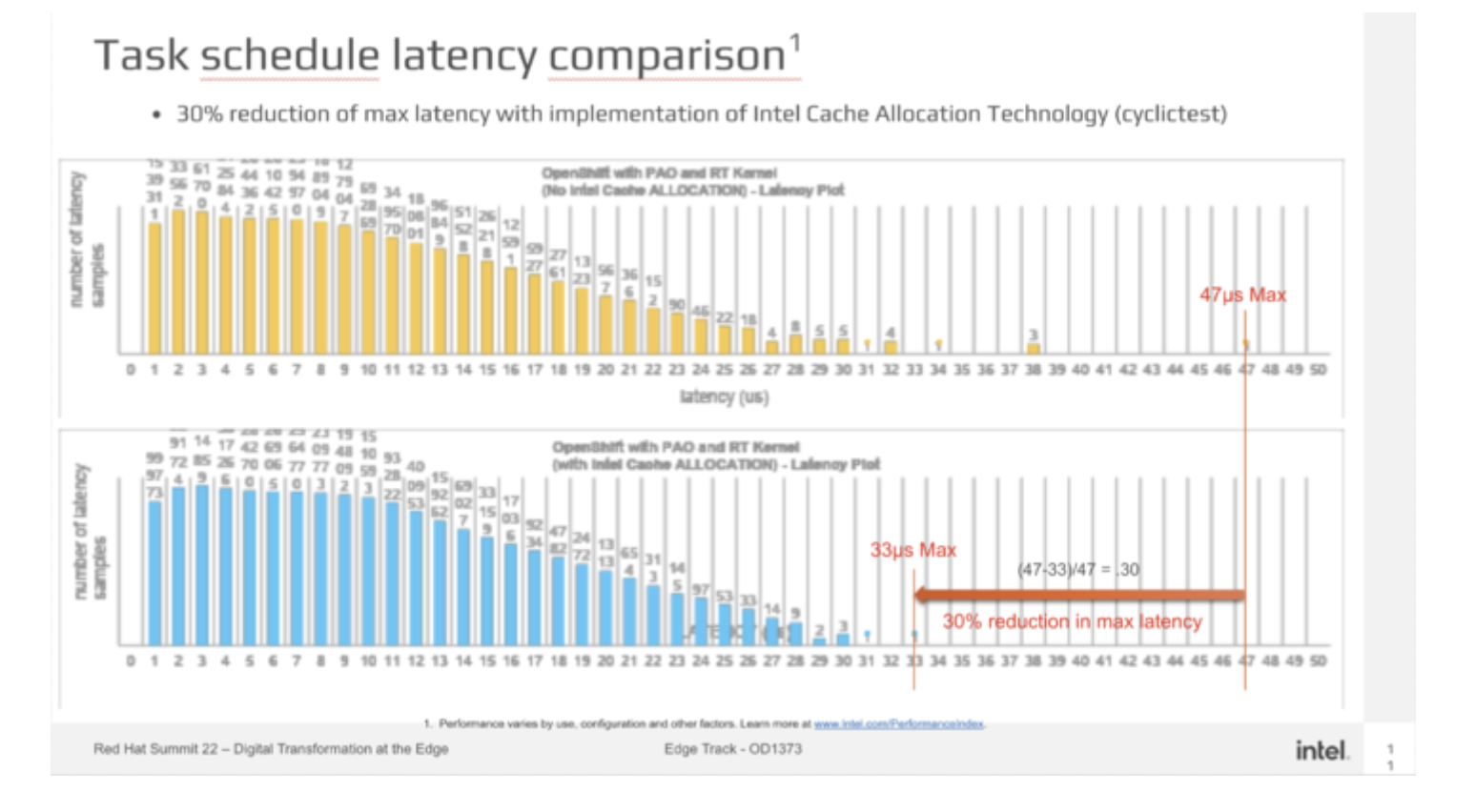The software-defined industrial control system is a huge opportunity for open source technologies. Moving away from bespoke specialized hardware (like PLC devices) to standard hardware with software only is a trend that crosses industries, extending now into the industrial and manufacturing world. This type of shift for industrial organizations is similar to telcos moving to network function virtualisation (NFV) and open radio access networks (ORAN).
Successfully implementing this trend, however, requires low latency capabilities. The controller has to respond quickly to an external event, such as a robot hitting a wall and stopping it before it actually makes contact. Please note that I avoid the term "real time", which requires specialized Real Time Operating Systems (RTOS). Instead, the best term to use is "predictable latency."
One of Red Hat’s answers to this burgeoning industrial trend is Red Hat Enterprise Linux (RHEL) for Real Time, which serves as the base for the Red Hat OpenShift Performance Addon Operator (PAO). While this was developed for the telco space, it’s very suitable for reuse for operational technologies and industrial control systems.
Together with Intel, we presented Digital Transformation at the Edge with Red Hat and Intel Edge Controls for Industrial, the result of a combined testing and evaluation effort between our two companies.
Let's take a look at the data:
 This test is done using Red Hat OpenShift on bare metal with the Performance Add-On Operator and the RHEL Real-Time kernel (RT-Kernel). Max latency (the time from event to response) is around 47 µsec to 33 µsec. This is more or less out of the box on standard hardware, with next to no special tuning besides activating Intel Cache Allocation Technology. This is already good enough for many industrial control system applications with PLC cycle times in the ~10 msec range, leaving enough headroom for the actual program execution.
This test is done using Red Hat OpenShift on bare metal with the Performance Add-On Operator and the RHEL Real-Time kernel (RT-Kernel). Max latency (the time from event to response) is around 47 µsec to 33 µsec. This is more or less out of the box on standard hardware, with next to no special tuning besides activating Intel Cache Allocation Technology. This is already good enough for many industrial control system applications with PLC cycle times in the ~10 msec range, leaving enough headroom for the actual program execution.
But it gets even better:
 This chart shows the value of the OpenShift Performance Add-On Operator and the RHEL RT-Kernel it deploys. Note that we switched from latency (how quickly does the system respond) to jitter (how consistently does the system respond, which is actually more important). You can see on a default system (standard kernel), it is around 57 msec — not acceptable for most control applications.
This chart shows the value of the OpenShift Performance Add-On Operator and the RHEL RT-Kernel it deploys. Note that we switched from latency (how quickly does the system respond) to jitter (how consistently does the system respond, which is actually more important). You can see on a default system (standard kernel), it is around 57 msec — not acceptable for most control applications.
But just by turning on the OpenShift Performance Add On Operator, with no additional tuning, this drops down to 55 µsec. That's an improvement of three orders of magnitude.
Let's take a look at what's possible when we add Intel capabilities to the equation:
 The reason for the left hand side wide deviations is CPU cache misses. If the code/data is not in the cache, it takes quite some time to fetch it from memory. First and second level caches can be disturbed by other workloads or processes running on the same core. Intel Cache Allocation Technology avoids this by dedicating parts of the CPU cache to a process.
The reason for the left hand side wide deviations is CPU cache misses. If the code/data is not in the cache, it takes quite some time to fetch it from memory. First and second level caches can be disturbed by other workloads or processes running on the same core. Intel Cache Allocation Technology avoids this by dedicating parts of the CPU cache to a process.
Looking at the new numbers, the old minimum turns into the new maximum, with a 76% reduction in max jitter.
Conclusion
The numbers show that low latency workload like industrial control systems can run on modern standard hardware in containerized environments. No need for special purpose devices, no need for long lasting heavy fine tuning. The out of the box performance characteristics are good enough for most use cases.
About the author
Daniel works as a Principal Product Manager at Red Hat. He is responsible for defining and managing the Red Hat OpenShift edge related projects including: MicroShift, Red Hat Device Edge and Single Node OpenShift products. Daniel is a catalyst that brings together the necessary resources (people, technology, methods) to make projects and products a success. Daniel has more than 25 years of experience in IT. In the past years, Daniel has focused on hybrid cloud and container technologies in the Industrial space.
More like this
Deterministic performance with Red Hat Enterprise Linux for industrial edge
Red Hat Enterprise Linux delivers deterministic performance for industrial TSN
A composable industrial edge platform | Technically Speaking
Open Curiosity | Command Line Heroes
Browse by channel
Automation
The latest on IT automation for tech, teams, and environments
Artificial intelligence
Updates on the platforms that free customers to run AI workloads anywhere
Open hybrid cloud
Explore how we build a more flexible future with hybrid cloud
Security
The latest on how we reduce risks across environments and technologies
Edge computing
Updates on the platforms that simplify operations at the edge
Infrastructure
The latest on the world’s leading enterprise Linux platform
Applications
Inside our solutions to the toughest application challenges
Virtualization
The future of enterprise virtualization for your workloads on-premise or across clouds
